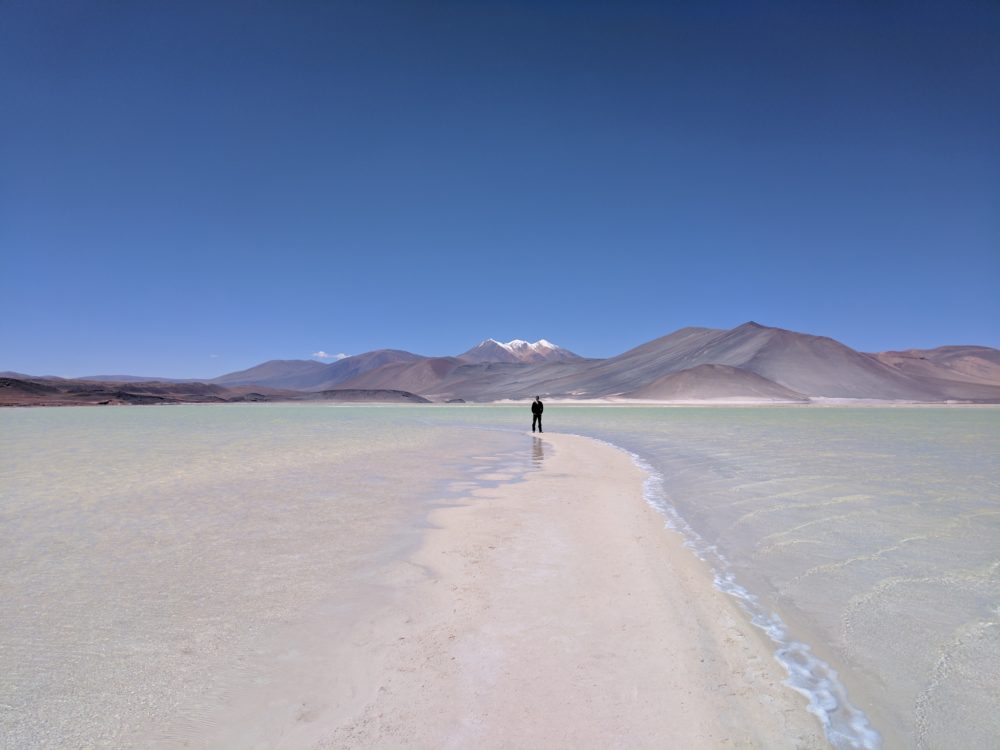With all of the beauty that San Pedro de Atacama holds, we are confident you will have a great time on your visit. That said, here are a few of San Pedro de Atacama travel tips that we picked up on our trip which we hope help you as you plan.
If you would rather hear about our 5 weeks in Chile, listen to the Podcast Episode – Podcast 28: Chile Travel – Santiago, Valparaiso, San Pedro de Atacama (& Other Beauty)
Transportation: TurBus offers a direct trip from Calama, Chile, and various other cities. The trip from Calama takes about 1.5 hours. The cost was 2,700 CLP per person ($4.20 USD). There are also flights available to Calama through LAN, Sky airline and PAL airline. Once at Calama airport there are shuttles available to San Pedro for 11,800 CLP per person ($18 USD).

Hotels/Hostels: There are many hotels and hostels in San Pedro de Atacama. Hotels tend to be a bit pricey. The average cost of a 5-star hotel in San Pedro is about $300 per night. There are several hotels that are 3 and 4-star hotels and hostels that are much more affordable. Note: Be sure to book your hotel or hostel well in advance if there is a hotel you really want to stay at. Hotels sell out months in advance. Hostels are a great option to help save money and give you more flexibility with your schedule and there are many options to choose from in San Pedro.
If you are looking to save some money, maybe camping is more ideal for you. Be sure you understand the basics of camping and what might be needed for this type of trip before you go.
Clothing: Due to the thermal fluctuation, it is necessary to bring summer clothing to wear during the day and winter (layered) clothing for the mornings and evenings. Make sure to bring hiking boots, gloves, and a warm coat if you plan to hike up a volcano or mountain as the temperatures can get to below 0. Other items you may want to bring are sunglasses, SPF lotion, a flashlight, and a camera to take photos of the fantastic sites.
Altitude Sickness: Another thing to consider during your stay is altitude sickness if hiking up volcanoes or mountains above 2,400 meters (8,000 feet). Altitude sickness varies from person to person. Primary symptoms of altitude sickness include a headache (could be confused with dehydration), gastrointestinal disorder (nausea, vomiting, loss of appetite), fatigue, dizziness, weakness, shortness of breath, and rapid pulse. The best way to avoid altitude sickness is to ascend SLOWLY. The rule of thumb is 1km/ hour. When we climbed it felt as if we were walking at a snail’s pace! Our guide made sure to explain to us that this was necessary for our bodies to acclimate to the change in altitude to prevent altitude sickness.

Hydration is key: It is best also to make sure you keep hydrated during your entire stay at San Pedro de Atacama due to the extreme dryness of the desert air. Make sure to bring bottled water with you when you go on your tours!
Propinas (tips): It is customary to leave a 10% tip (like Santiago) in restaurants, cafes, bars, etc. It is also customary to tip your guides and taxi drivers as well.
Navigating around downtown San Pedro: Downtown San Pedro is quite small. Everything is within walking distance and there is no need to take a taxi to and from Point A to Point B. If you are in need of a bank, groceries, trinkets, restaurants, tour agency, a bottle of wine, church, etc., it can be found on the main street, Caricoles.
Traveled March 2017
I plan to go to the Atacama desert but not very early…waiting for the end of covid 19 crisis ans Latam to trip from Tahiti to Chile.
Please send me more informations on the places to visit in Chile despite of Santiago and Valparaiso.
Good plan for me
Sounds exciting! I would also check out these posts for ideas – https://passportjoy.com/chile-travel-tips/ – https://passportjoy.com/central-chilean-coast/ – https://passportjoy.com/antofagasta-chile/ – https://passportjoy.com/puerto-varas/ – You might also want to consider heading north to Peru.